US Dollar Exchange Rates of
25th
Oct
2023
China Yuan 7.30
Report from China
Investment
in real estate
Between January and September investment in real estate
development was 8,726.9 billion yuan, a year-on-year
decrease of 9%. Investment in residential buildings was
6,627.9 billion yuan, down by 8.4%.
In the first nine months of 2023 the floor space under
construction was 8,156.88 million square metres, a year-
on-year decrease of 7% and the under construction floor
space of residential buildings was 5,742.50 million square
meters, down by 7.4%.
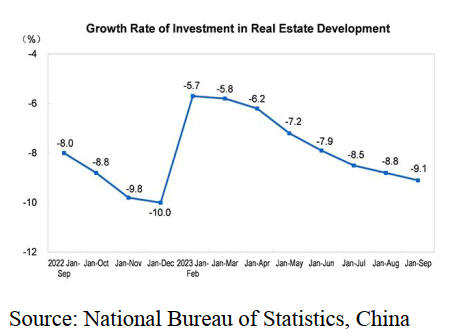
Retail sales in September 2023
In September this year retail sales of consumer goods
reached 3,982.6 billion yuan, a year-on-year increase of
5.5% and retail sales, other than automobiles, reached
3,544.3 billion yuan, up by 5.9%. Sales of furniture rose
0.5% in September and rose by 3% in the first nine months
of this year. However, sales of Building and Decoration
materials dropped 8% in September and arealso down 8%
for the year to September.
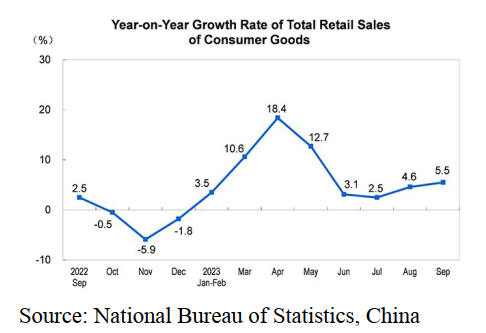
From January to September retail sales of consumer goods
in urban areas increased almost 7% year on year as did
sales in rural areas.
Formaldehyde-free wood-based panel market share
The output of China's wood-based panesl in 2021wase
336.73 million cubic metres, a year on year increase of 8%
and came after four consecutive years of growth.With the
improvement of people's living standards in China the
safety of the living room environment became a topic of
concern and demand for formaldehyde-free wood-based
panel products increased.
The formaldehyde-free wood-based panel industry
With the green upgrading of the wood-based panel
industry the production of formaldehyde-free wood-based
panel products has steadily increased and the market share
of these products continues to expand.
The output of formaldehyde-free wood-based panel
products was about 8.1 million cubic metres in 2022.
Formaldehyde-free plywood, fiberboard and particle board
was 1.6 million cubic metres, 0.2 million cubic metres and
6.3 million cubic metres respectively, a year on year
increase of 36%.

The output of formaldehyde-free plywood products in
China has maintained a steady growth trend in recent
years, a year on year increase of 37% in 2021 and 36% in
2022. The proportion of formaldehyde-free particleboard
is largest at 57% in 2020, 62% in 2021 and 78% in 2022.
The varieties of formaldehyde-free products have
expanded and the main adhesives include aqueous
polyurethane adhesives (EPI), bean-based protein
adhesives, lignin adhesives and thermoplastic resin film
adhesives, etc.
Formaldehyde-free plywood is mainly madewith
polyurethane, bean-based protein, thermoplastic film
adhesives in China. The proportion of formaldehyde-free
plywood made with bean-based protein adhesives
dominated and was 64% (800,000 cubic metres) in 2020,
57% in 2021 (770,000 cubic metres) and 63% (1 million
cubic metres) in 2022.
Formaldehyde-free fiberboard is mainly made with
polyurethane and bean-based protein in China. The
proportion of formaldehyde-free fiberboard made by
polyurethane adhesives dominated and is 83% (500,000
cubic metres) in 2020, 87% in 2021 (770,000 cubic
metres) and 50% (100,000 cubic metres) in 2022.
Formaldehyde-free particle board is mainly made by
polyurethane (MDI), polyurethane (EPI) and bean-based
protein adhesives in China. The proportion of
formaldehyde-free particle board made by polyurethane
(MDI) adhesives dominated and is 80% (2 million cubic
metres) in 2020, 83% in 2021 (3.08 million cubic metres)
and 90% (5.65 million cubic metres) in 2022.
Current formaldehyde emission limits for wood-based
panels
Formaldehyde release is an important indicator to evaluate
environmental performance of wood-based panels
products. There are 7 formaldehyde emission limits for
wood-based panel products in China, including 4 national
standards, 1 environmental protection industry standard
and 2 group standards.
Technical indicators of current formaldehyde emission
limits of wood-based panel have reached international
standards, of which the ENF level (0.025mg /m³) in GB/T
39600-2021 ‘The classification of Formaldehyde
emission for wood-based panels products’ is the most
stringent international requirements for formaldehyde
emission limits of wood-based panels products. ENF
levels are commonly known as formaldehyde-free levesl
in the industry. It mainly provides the formaldehyde limit
index that consumers are most concerned about.
Group standard T/CNFPIA 3002-2018 "Formaldehyde-
free wood-based panels products" gives the definition of
formaldehyde-free wood-based panels and gives the
requirements from the use of adhesive, formaldehyde
release limit (0.03 mg/m³) and TVOC release rate not
exceeding 0.50 mg/ (m2·h) (72 h).
The soluble heavy metal content of formaldehyde-free
wood-based panel products with color paint finish should
also meet the requirements of GB 18584-2001 ‘Interior
decoration materials harmful substances limits in wood
furniture’.
Non-formaldehyde and low-formaldehyde products are the
future development direction and the research on the
revision of China's formaldehyde-free wood-based panel
industry standards continues to promote the green
development of wood-based panel products industry.
Application of non-formaldehyde wood-base panel
products
More than 95% of formaldehyde-free wood-based panels
products have surface finishes. The main finishing
methods include impregnated film paper finishing, high-
pressure laminates (HPL), polypropylene (PP) finishing,
paint finishing, polyvinyl chloride (PVC) film finishing
and continuous pressure laminate (CPL) finishing.

For the limits of indoor use for wood-based panels, GB
39598-2021’The Guidelines for indoor load limits of
wood-based panels on limiting formaldehyde release’
provides the calculation method for indoor load limits of
wood-based panels on the limit amount of formaldehyde
release and other information to be considered.
It is suitable for wood-based panels used in wood products
such as interior furniture, cabinets, wooden doors, wooden
wallboards and wooden floors. Depending on use
consumers can choose between E1, E0 and ENF grade or
formaldehyde-free wood-based panels products.
ENF grade and formaldehyde-free wood-based panel
products are more suitable for use in a space where the
amount of wood-based panel products is large, the space
used by sensitive people, special places such as hospitals,
nursing homes and kindergartens and special consumer
groups.
Future development prospect
The proportion of formaldehyde-free wood-based panel
products will continue to expand and the substances that
affect human health such as VOC release and free phenol
in the production process and use will gradually attract
consumer attention.
The variety of formaldehyde-free wood-based panel
products will be further enriched and the production
efficiency and quality requirements will be further
improved.
The functional requirements of formaldehyde-free and
wood-based panel products will gradually be combined
and functional formaldehyde-free products, such as ultra-
thin, shaped, flame retardant, moisture-proof, antibacterial,
insect-proof, anti-static and low-odor products, will
become one of the main development directions according
to different application fields and places. The development
of formaldehyde-free finishing materials will become
more urgent.
Decline in imported log and sawnwood CIF prices
According to China Customs, between January and
September 2023 CIF prices for logs and sawnwood
imports declined year on year.
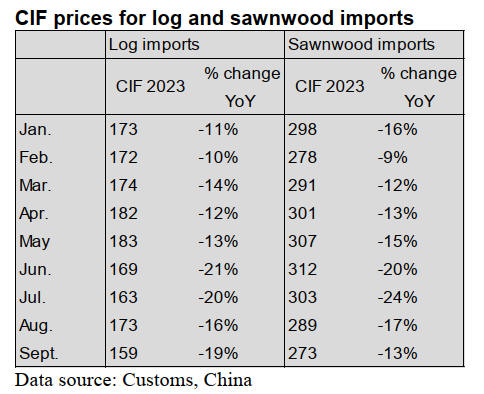
The decline in CIF prices for both logs and sawnwood
imports was because global ocean freight rates have fallen
sharply and because stocks at Chinese ports iare high due
to weak demand.
Largest Russian timber company shipping plywood to
China
It has been reported that the company Sveza Uralsky
(formerly Perm Plywood Factory) the largest plywood
manufacturer in Russia’s Perm Krai Region has started
shipping plywood to China. Sveza Uralsky lost its markets
in Europe in 2022 due to Western sanctions and company
revenues fell dramatically and the company posted net
losses for several years. The company has diversified with
new markets such as East Asia, CIS countries, the Middle
East and Africa.
According to the Russian Animal and Plant Inspection and
Quarantine Bureau the export of birch plywood from Perm
Krai to China increased to 8,800 cubic metres between
January and August.
See:http://www.rc-sc.cn/newsshow.aspx?mid=380&id=8820
GTI-China index for September
In September the GTI-China index registered 37.3%, a
decrease of 15.3 percentage points compared to that of the
previous month, falling below the critical value (50%)
after 2 months and indicating that the business prosperity
of the timber enterprises represented in the GTI-China
index shrank from August.
The production index registered 34%, a decrease of 22
percentage points from the previous month and fell below
the critical value after 2 months indicating that the
production volume of the timber enterprises represented in
the GTI-China was less than that of August.
The new orders index registered 40%, a decrease of 13
percentage points from the previous month and fell below
the critical value after 2 months indicating that the number
of new orders of the timber enterprises represented in the
GTI-China was less than that of August.
The export orders index registered 50%, an increase of 8
percentage points from the previous month and rose after 5
months indicating that the number of export orders of the
timber enterprises represented in the GTI-China was the
same with that of August.
On 15 September the National Bureau of Statistics
released macroeconomic data for August. In terms of trade
China's exports in August were down 3.2% and imports
were down 1.6%. In the industrial sector profits of
industrial enterprises grew by 17% year-on-year and
achieved positive growth for the first time since the second
half of last year.
The General Office of the Central Committee and the
General Office of the State Council jointly issued a "Plan
on Deepening the Reform of the Collective Forest Right
System" which outlines multiple tasks for instance to
support eligible forestry carbon sink projects.
See:https://www.itto-ggsc.org/static/upload/file/20231017/1697507334917952.pdf
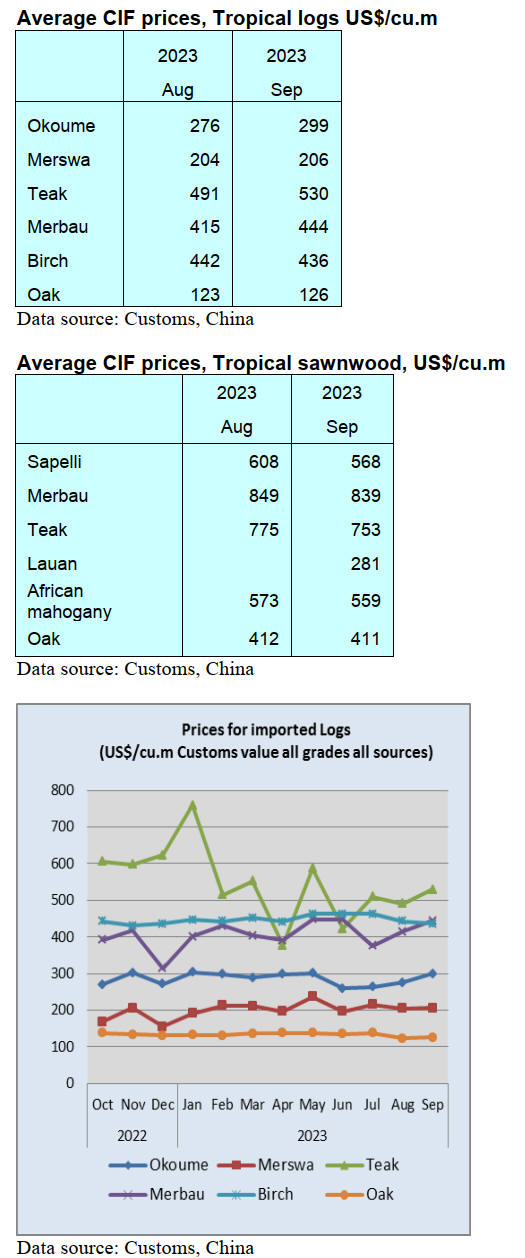
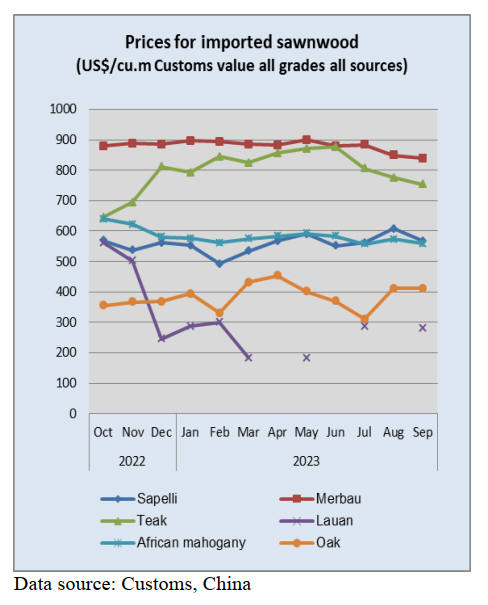
|